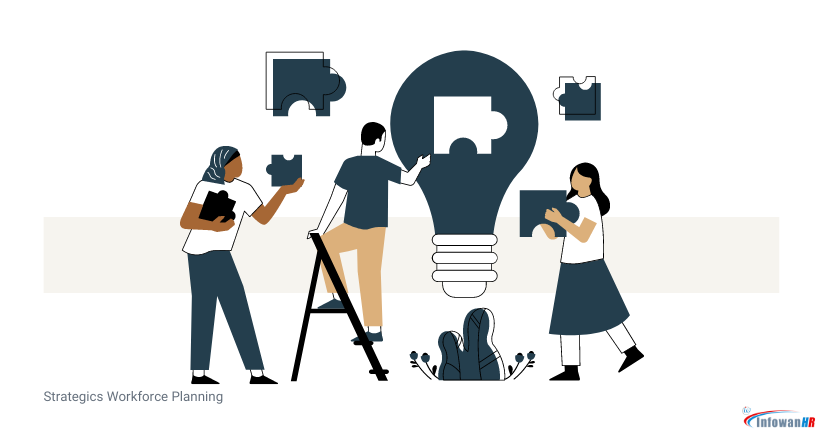
How can we help you today?
Registered Office
Infowan Technologies Pvt Ltd
Mumbai-401107. INDIA.
Contact Details
+91 98201 97205
+91 98201 26871
+91 98670 74415
support@infowan.net
info@infowan.net
|
Table of Contents
|
|---|
| Strategic Workforce Planning for HRBPs: Aligning HR with Business Objectives |
| The Evolution of HRBP Roles |
| Strategic Workforce Planning |
| Strategic workforce planning is crucial for several compelling reasons: |
| Challenges and Considerations |
| Conclusion |

In today's dynamic business landscape, where change is the only constant, Human Resource Business Partners (HRBPs) are at the forefront of helping organizations navigate the challenges of workforce management. HRMS payroll software plays a vital role in managing employees, tracking skills, demographics, education, experience certifications, etc. This information can be used to identify potential skill gaps and develop workforce development programs.
The Evolution of HRBP RolesOriginally, HRBPs were seen as generalists who supported HR operations and provided administrative support. However, as organizations have become more complex and competitive, the HRBP role has become more strategic and focused on aligning HR practices with business objectives. Today, HRBPs are expected to be true partners to business leaders, providing insights and guidance on a variety of HR issues, from talent management to organizational design. This shift has required HRBPs to develop a broad range of skills, including business acumen, data analysis, and change management. As the business landscape continues to evolve, the HRBP role is likely to continue to change and adapt to meet the needs of organizations.
The HRBP (Human Resources Business Partner) role has evolved significantly over the years. Here are some ways in which this role has changed:
• From a transactional to a strategic focus: HRBP roles used to be primarily focused on administrative tasks such as recruiting, onboarding, and benefits management. Today, HRBPs are expected to take a more strategic approach, aligning HR goals with business objectives and driving organizational change.
• From a generalist to a specialist focus: In the past, HRBPs were responsible for all aspects of HR, from recruitment to benefits to employee relations. Today, HRBPs are often specialists in specific areas such as talent management or employee engagement.
• From a reactive to a proactive role: HRBPs used to be primarily reactive, responding to employee issues as they arose. Today, HRBPs are expected to be proactive, anticipating issues before they occur and developing strategies to address them.
• From compliance to a risk management focus: In the past, HRBPs were responsible for ensuring compliance with labor laws and regulations. Today, HRBPs are also responsible for managing risk, ensuring that the organization is protected from legal and reputational harm.
• From a local to a global focus: As organizations have become more global, HRBPs are now expected to have a global perspective and be able to manage HR issues across borders and cultures.
Strategic Workforce PlanningStrategic workforce planning involves aligning HR objectives with the organization's overall business strategy. This process helps to ensure that the business has the right people in the right roles at the right time to achieve its objectives. HRBPs must have a clear understanding of the organization's business goals and the skills and capabilities required to achieve them. By aligning HR objectives with business objectives, HRBPs can develop effective workforce plans that anticipate future talent needs, identify skill gaps, and ensure that the organization has the talent it needs to succeed. HR software with people analytics helps make the skill gap or workforce analysis quicker with the help of dashboards containing your organization's data. You can quickly identify skill gaps and make data-driven decisions to address them. This can help you optimize your workforce and improve employee performance. Additionally, Payroll HR software can help streamline administrative tasks and free up time for your HR team to focus on more strategic initiatives. Overall, incorporating employee management systems with people analytics can help your organization stay competitive in today's rapidly evolving business landscape.
Strategic workforce planning is crucial for several compelling reasons:
Why is it Crucial for HRBPs?
1. Long-Term Sustainability: Companies with a strategic approach to workforce planning are better positioned for long-term sustainability. They can weather economic downturns, industry disruptions, and other challenges more effectively.
2. Talent Acquisition and Retention: By analyzing current workforce capabilities and future needs, organizations can develop strategies for talent acquisition, development, and retention. This includes hiring the right people, training and upskilling existing employees, and implementing succession plans to ensure leadership continuity.
3. Risk Mitigation: Strategic workforce planning allows organizations to identify and mitigate HR-related risks. For example, it helps in anticipating talent shortages or skill gaps and taking corrective actions before these issues become critical.
4. Improved Decision-Making: Data-driven decisions are more effective than those based on intuition alone. Workforce planning relies on data and analytics to inform decisions, enhancing their accuracy and effectiveness.
5. Compliance and Diversity: Strategic workforce planning ensures compliance with labor laws and regulations. It also promotes diversity and inclusion by identifying areas where diversity efforts are needed and creating plans to address them.
6. Proactive Approach: Rather than reacting to immediate staffing needs, strategic workforce planning takes a proactive stance. It enables organizations to anticipate future talent requirements and prepare accordingly, minimizing the disruptions caused by sudden workforce gaps.
Challenges and ConsiderationsStrategic workforce planning can be complex and requires access to accurate data, collaboration with business leaders, and the ability to adapt to changing circumstances. HRBPs must be prepared to address these challenges effectively.
ConclusionIn today's competitive business environment, strategic workforce planning is no longer optional; it's a necessity. HRBPs play a pivotal role in this process, ensuring that HR practices are closely aligned with organizational objectives. By embracing this strategic approach, HRBPs can help organizations thrive in an ever-evolving landscape, securing their position as invaluable contributors to the company's success.